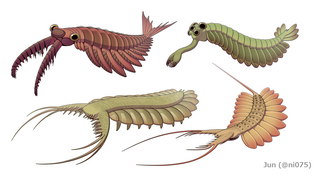
Dinocaridida is a proposed fossil taxon of basal arthropods that flourished in the Cambrian period with occasional Ordovician and Devonian records. Characterized by a pair of frontal appendages and series of body flaps, the name of Dinocaridids refers to the suggested role of some of these members as the largest marine predators of their time. Dinocaridids are occasionally referred to as the 'AOPK group' by some literatures, as the group compose of Radiodonta, Opabiniidae, and the "gilled lobopodians" Pambdelurion and Kerygmachelidae. It is most likely paraphyletic, with Kerygmachelidae and Pambdelurion more basal than the clade compose of Opabiniidae, Radiodonta and other arthropods.

Anomalocaris is an extinct genus of radiodont, an order of early-diverging stem-group arthropods.
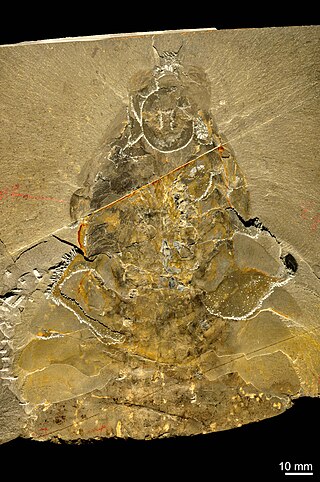
Peytoia is a genus of hurdiid radiodont, an early diverging order of stem-group arthropods, that lived in the Cambrian period, containing two species, Peytoia nathorsti from the Miaolingian of Canada and Peytoia infercambriensis from Poland, dating to Cambrian Stage 3. Its two frontal appendages had long bristle-like spines, it had no fan tail, and its short stalked eyes were behind its large head.

Amplectobelua is an extinct genus of late Early Cambrian amplectobeluid radiodont, a group of stem arthropods that mostly lived as free-swimming predators during the first half of the Paleozoic Era.

Anomalocarididae is an extinct family of Cambrian radiodonts, a group of stem-group arthropods.

Pambdelurion is an extinct genus of panarthropod from the Cambrian aged Sirius Passet site in northern Greenland. Like the morphologically similar Kerygmachela from the same locality, Pambdelurion is thought to be closely related to arthropods, combining characteristics of "lobopodians" with those of primitive arthropods.

Parapeytoia is a genus of Cambrian arthropod. The type and only described species is Parapeytoia yunnanensis, lived over 518 million years ago in the Maotianshan shales of Yunnan, China. Unidentified fossils from the same genus also had been discovered from the nearby Wulongqing Formation.
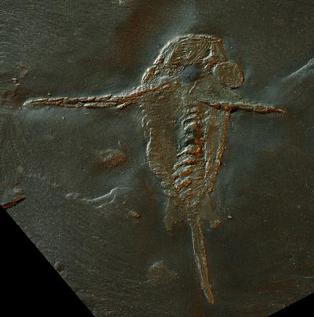
Schinderhannes bartelsi is a species of hurdiid radiodont (anomalocaridid) known from one specimen from the lower Devonian Hunsrück Slates. Its discovery was astonishing because previously, radiodonts were known only from exceptionally well-preserved fossil beds (Lagerstätten) from the Cambrian, 100 million years earlier.

Radiodonta is an extinct order of stem-group arthropods that was successful worldwide during the Cambrian period. They may be referred to as radiodonts, radiodontans, radiodontids, anomalocarids, or anomalocaridids, although the last two originally refer to the family Anomalocarididae, which previously included all species of this order but is now restricted to only a few species. Radiodonts are distinguished by their distinctive frontal appendages, which are morphologically diverse and used for a variety of functions. Radiodonts included the earliest large predators known, but they also included sediment sifters and filter feeders. Some of the most famous species of radiodonts are the Cambrian taxa Anomalocaris canadensis, Hurdia victoria, Peytoia nathorsti, Titanokorys gainessii, Cambroraster falcatus and Amplectobelua symbrachiata, the Ordovician Aegirocassis benmoulai and the Devonian Schinderhannes bartelsi.

Stanleycaris is an extinct, monotypic genus of hurdiid radiodont from the middle Cambrian (Miaolingian). The type species is Stanleycaris hirpex. Stanleycaris was described from the Stephen Formation near the Stanley Glacier and Burgess Shale locality of Canada, as well as Wheeler Formation of United States. The genus was characterized by the rake-like frontal appendages with robust inner spines.

Caryosyntrips ("nutcracker") is an extinct genus of stem-arthropod which known from Canada, United States and Spain during the middle Cambrian.
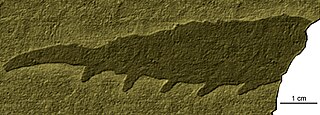
Mureropodia is an animal that existed in what is now the Valdemiedes Formation of Spain during the early Cambrian period. It was described by José Antonio Gámez Vintaned, Eladio Liñán and Andrey Yu. Zhuravlev in 2011, and the type and only species is M. apae.
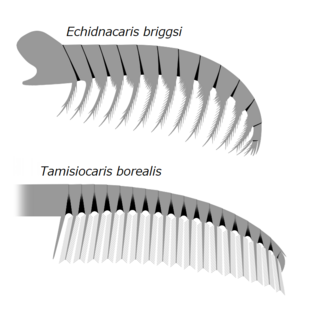
Tamisiocarididae is a family of radiodonts, extinct marine animals related to arthropods, that bore finely-spined appendages that were presumably used in filter-feeding. When first discovered, the clade was named Cetiocaridae after a speculative evolution artwork, Bearded Ceticaris by John Meszaros, that depicted a hypothetical filter-feeding radiodont at a time before any were known to exist. However, the family name was not valid according to the International Code of Zoological Nomenclature, as no real genus named "Cetiocaris" exists, and in 2019 it was formally replaced by the name Tamisiocarididae, after the only valid genus of the clade at the time. The family is only known from Series 2 of the Cambrian, unlike other radiodont families, which persisted longer into the Cambrian. All known species would have lived in tropical or subtropical waters, suggesting a preference for warmer waters.

Lyrarapax is a radiodont genus of the family Amplectobeluidae that lived in the early Cambrian period 520 million years ago. Its neural tissue indicates that the radiodont frontal appendage is protocerebral, resolving parts of the arthropod head problem and showing that the frontal appendage is homologous to the antennae of Onychophorans and labrum of euarthropods. Its fossilized remains were found in Yunnan in southwestern China. A second species was described in 2016, differing principally in the morphology of its frontal appendages. It is a small animal, measuring up to 8 cm (3.1 in) in total body length.

Hurdiidae is an extinct cosmopolitan family of radiodonts, a group of stem-group arthropods, which lived during the Paleozoic Era. It is the most long-lived radiodont clade, lasting from the Cambrian period to the Devonian period.

Ramskoeldia is a genus of amplectobeluid radiodont described in 2018. It was the second genus of radiodont found to possess gnathobase-like structures and an atypical oral cone after Amplectobelua. It was discovered in the Chengjiang biota of China, the home of numerous radiodontids such as Amplectobelua and Lyrarapax.

Paranomalocaris is a genus of radiodont recovered from the Cambrian Stage 4 aged Wulongqing Formation, eastern Yunnan. It contains two species, Paranomalocaris multisegmentalis and P. simplex. It is only known from its frontal appendage.

Houcaris is a possibly paraphyletic radiodont genus, tentatively assigned to either Amplectobeluidae, Anomalocarididae or Tamisiocarididae, known from Cambrian Series 2 of China and the United States. It contains two species, Houcaris saron and Houcaris magnabasis, both of which were originally named as species of the related genus Anomalocaris. The genus Houcaris was established for the two species in 2021 and honors Hou Xianguang, who had discovered and named the type species Anomalocaris saron in 1995 along with his colleagues Jan Bergström and Per E. Ahlberg.

Laminacaris is a genus of extinct stem-group arthropods (Radiodonta) that lived during the Cambrian period. It is monotypic with a single species Laminacaris chimera, the fossil of which was described from the Chengjiang biota of China in 2018. Around the same time, two specimens that were similar or of the same species were discovered at the Kinzers Formation in Pennsylvania, USA. The first specimens from China were three frontal appendages, without the other body parts.

Guanshancaris is an extinct genus of amplectobeluid radiodont known from the Cambrian Stage 4 Guanshan Biota of southern China. It is only known from a single species. G. kunmingensis which was described in 2013 as a species of Anomalocaris before being placed in a new genus in 2023. Like many other radiodonts, it is only known from fragmentary remains, including its frontal appendages and the oral cone. It has been suggested to have been durophagous.





















